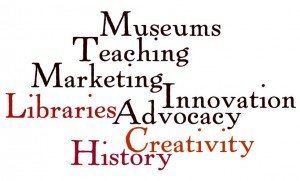 Many of the entries and news items here at the New York History blog highlight innovative practices and initiatives to broaden public visibility and support.
Many of the entries and news items here at the New York History blog highlight innovative practices and initiatives to broaden public visibility and support.
Sharing information and descriptions of good practices is a useful strategy for strengthening our programs. Here are a few examples that may be of interest:
Creative practices in museums. Linda Norris’ blog, The Uncataloged Museum is an excellent source of information about museum practices, particularly how museums interact with audiences. Ms. Norris, who lives in Treadwell, NY, says on the blog site that “I work with museums and think, talk, debate, dream and wonder about their place in the world.” She is the co-author of a forthcoming book on Museums and Creative Practice and has been using the book’s website to solicit ideas and share suggestions for sources.
Users help shape exhibits and programs. The Museum 2.0 blog focuses on involving audiences in planning for museum exhibits and actively engaging them as visitors in museums. It’s mostly about art museums, but has insights applicable to history programs as well. Nina Simon, who writes the blog, is a leading expert in this field and has also written a useful book, The Participatory Museum.
Users generate content. Historypin is a site featuring user-generated historical photos, videos, personal recollections, and other materials. Users “pin” their materials to geographical locations using Google maps. “Historypin is a way for millions of people to come together, from across different generations, cultures and places, to share small glimpses of the past and to build up the huge story of human history,” says its web site. There is a good deal of interesting material on the site but accessing things thematically is challenging.
Advocacy strategies. The American Association of Museums is preparing for Museums Advocacy Day in Washington on February 25-26. There is considerable material on their web site about how to lobby Congress for federal programs but also material on more general advocacy strategies.
Developing strategies for marketing. The National Arts Marketing Project provides a variety of resources for marketing the arts, broadly defined. Much of the material is applicable to history programs with some creative interpretation. For instance, they have a series of short “practical lessons” which include “The Big Picture: The Marketing Challenge for the Arts,” “Finding Your Audience through Marketing Segmentation, “Attracting Diverse Audiences,” and “Marketing the Arts on the Internet.”
Staying vibrant in a changing world. Libraries are facing some of the same issues that confront historical programs: tight budgets, changing demographics, shifting user needs and expectations, evolving technology. Surveys and reports from the library community have some insights for us, for instance American Library Association, The State of America’s Libraries 2012 [pdf]. The ALA’s web site has useful advocacy information. An affiliated group, the Association of Library Trustees, Advocates, Friends and Foundations has additional advocacy and lobbying recommendations.
State grants for history projects. New York would benefit from a state history grant program. The Minnesota Historical Society’s Historical and Cultural Heritage Grants provide support for history projects in that state. Funds are provided through the Clean Water, Land and Legacy Amendment to the state constitution, approved by the voters in 2008. Most of the funds are used for natural resources but the amendment mandated that a portion of the funding be used “to preserve Minnesota’s history and cultural heritage.” The Society is conducting a series of meetings around the state to solicit input on categories for future grants.
The Ohio Historical Society’s History Fund grant program provides grants for history projects. The grants, awarded on a competitive basis, require a partial cash or in-kind match. The program is funded by individual citizens of Ohio who donate a portion of their state income tax refund or donate directly to Ohio Historical Society.
Teaching historical thinking. A new book published in Canada has useful insights for the teaching of history in social studies courses. Peter Seixas and Tom Morton, The Big Six Historical Thinking Concepts, published by Nelson Education (2012) covers Historical Significance, Evidence, Continuity and Change, Cause and Consequence, Historical Perspectives and The Ethical Dimension.
Thanks so much for the shout-out Bruce….definitely in some very nice company!